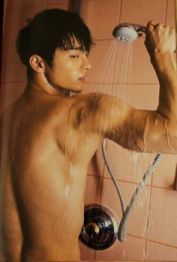To go along with the excerpts from KAGAMI, and to expand a bit on pieces of Japanese culture and life that pop up now and then, Sugoi! posts are here, starting with number one (this one): secrets of the soak!
With Japanese culture making waves in the West, a number of things have started to stick out as “different”. Some of them are pretty obvious, but at the same time, ‘obvious’ observations come with some…well, not-so-obvious limitations. Manners and customs, like anything else, grow up in a culture over many years, and generally for a reason (even if the reason has been forgotten). You can’t see them just by looking at a thing, and it takes time to adapt to new manners and traditions – but it helps to know what you’re getting into before you literally get into it!
A Little Bit Of History
Everything about bathing in Japan, including the bathroom itself – the ofuraba – is just a little different. The story of the Japanese bath starts with the onsen and sento. An onsen is the kind of bath that we’d all love to vacation at: a natural hot spring.

Since the Japanese islands are volcanic, hot springs are all over the place, and have traditionally served as public baths. Fun fact – the oldest hotel in the world, according to the Guinness Book of World Records, is Japan’s Nishiyama Onsen Keiunkan – it’s been operating since 705 AD! As the name gives away, the Keiunkan’s onsen are one of its main attractions. But despite the fact that Japan is volcanic, there aren’t an infinite number of hot springs, so as the population grew, sento sprang up to fill the gaps. Just like the onsen, sento serve as public bathhouses, but instead of hot springs, they’re more like a bath at home. There are generally showers and/or faucets to bathe with, along with pools for relaxation, but they’re just filled with heated tap water.

Sento can be traced back to the Nara period, during the 700’s, when Buddhism started making inroads in Japan. Steam baths in temples became commercial bathhouses over the course of several hundred years (there’s mention of one in 1266), but these were still steam baths – tiny, dark, humid rooms where a patron was sent with their hot water ration, since there were no faucets yet. Skip ahead a few centuries more to the Edo period, and by the 1800’s, baths were beginning to look more like one might find in a modern sento.
Keep in mind, both onsen and sento are public baths, and traditionally, kon’yoku, or mixed-gender bathing, was allowed. However, during the 1800’s, kon’yoku was gradually banned more and more as Japan was opened to the West, making it rare nowadays to find a bath that offers such an option. And of course, as it became easier and more affordable to have a bath at home, fewer people frequented the public baths in general. Modern Japan’s houses and apartments have their own baths, just as in the West, even if a Japanese ofuraba isn’t much like a Western bathroom. Sento linger, regardless, as places for people to bond and as cultural centers that serve as a reminder of old times. Onsen are now an enormous part of the Japanese tourist industry, but they’re also a fixture of the modern Japanese lifestyle. Not much beats a weekend at a hot spring!
Inside The Ofuraba
Now, to the important stuff! If you’ve read the scene I posted, or are an anime person (I see you, otaku!), you’ll be familiar with the fact that the ofuraba is nothing like a Western bathroom.

Firstly, ofuraba is better translated as ‘bathing room’ than ‘bathroom’, because toilets in Japan have their own space – they aren’t in the same room as the bath. Secondly, the ofuraba is usually a smaller room than Western bathrooms, often like a walk-in shower with the tub along one wall. Finally, ofuro, Japanese bathtubs, are deeper than Western tubs, but also smaller. They’re meant for soaking, not for “bathing” in the sense of washing.

Ofuro themselves used to be nothing more than wooden boxes, or even cauldrons with a fire underneath, but like everything else these days, technology has gone to work on them. Now you can find ofuro made of exotic materials, with all kinds of upgrades like the ones that come with Western bathtubs. The shape, however, remains classically Japanese, and a square tub with flat sides that don’t slope makes a definite change from a Western tub.
But the strangest part about bathing in Japan for a Westerner is probably the process of bathing itself. Instead of soaping up in the tub, or just climbing into a tub of hot water and rinsing in the shower afterward, ofuro are meant for soaking after you’ve already washed. When you walk into the ofuraba, you scrub off first, outside the ofuro. Usually that means showering – Japan is probably the number one place in the world for movable showerhead-hoses. In more old-fashioned homes, the bucket-and-rinse method is still used, but in either case, it’s a huge faux pas to enter the bath without having at least rinsed off first.

It’s just as important you make sure not to get soap in the yubune – the bathwater – as it is to make sure you scrub beforehand! Often the bathwater isn’t changed between soakers, but daily. Instead, the ofuro and yubune are covered while not being used, much like a jacuzzi, and the water is reheated later – though these days, recirculation systems make it easy to keep the water hot.
It’s also not uncommon for people to bathe together, even at home in ‘private’ baths. There’s the obvious necessity of making sure kids get clean, which means families tend to bathe together, but more than that, bathing is a ritual in Japan that promotes closeness. There’s even a special term for it: hadaka no tsukiai, which translates roughly to “naked communion”, or “skinship”. The idea is that in the relaxed, necessary openness enforced by nudity, people bond more easily and honestly. This has been important enough that older Japanese people are expressing concern for modern children, who are growing up without the custom of public bathing. As to whether or not the custom dies out completely, only time will tell.

Regardless of whether one bathes alone or with others, the idea of bathing as leisure time, as well as something beneficial to health and hygiene, is deeply engrained in Japanese culture. It’s a lifestyle I’m having fun adapting as I write. I don’t have a furo, but a nice long soak is a wonderful way to relax…and contemplate the next thing Sugoi!
P.S: For those wondering how I picture Akira’s ofuraba, the one described in the excerpt, take a look at this little gem! It’s even got a shoji in the background (a Japanese sliding door) and what I can only imagine is a grumpy Kagami, soaking alone!



 Akira stripped off his shirt, was suddenly half-naked, and the shifting muscles under the skin of his bare back incited a need Kagami had never experienced before. Was this desire? This feeling, tight in his belly, hot in his chest, a startled ember rolling down his spine. His heartbeat – that he had a heartbeat – Kagami grew aware of its pulsing in his fingertips, the trapped, rigid length of his sudden erection, his lips, his tongue… Warmth fled his fingertips for his cheeks and the tops of his ears.
Akira stripped off his shirt, was suddenly half-naked, and the shifting muscles under the skin of his bare back incited a need Kagami had never experienced before. Was this desire? This feeling, tight in his belly, hot in his chest, a startled ember rolling down his spine. His heartbeat – that he had a heartbeat – Kagami grew aware of its pulsing in his fingertips, the trapped, rigid length of his sudden erection, his lips, his tongue… Warmth fled his fingertips for his cheeks and the tops of his ears. A rough rush of something like summer lightning spurred Kagami forward a step, had him reaching out, but he jerked his hand back as Akira doused himself with spray. It came from a shower head outside the ofuro, and Kagami regarded it with interest…but not as much as Akira. Wasn’t the bath already full of water? Why would he need to get wide outside of it? But when he was wet all over, the man sat on the stool, took a washcloth and soap and started to scrub himself around blossoming purple bruises. “If you’re gonna stand there and stare, you wanna wash my back?”
A rough rush of something like summer lightning spurred Kagami forward a step, had him reaching out, but he jerked his hand back as Akira doused himself with spray. It came from a shower head outside the ofuro, and Kagami regarded it with interest…but not as much as Akira. Wasn’t the bath already full of water? Why would he need to get wide outside of it? But when he was wet all over, the man sat on the stool, took a washcloth and soap and started to scrub himself around blossoming purple bruises. “If you’re gonna stand there and stare, you wanna wash my back?” Kagami gloried in being looked at, being seen, as much as in the fact that Akira seemed to return his desire. “I can…I can do that.” It was only as he took the cloth from Akira’s hands and started to rub it against his shoulder that Kagami realized this gave him permission to touch without misgivings or embarrassment. He stopped moving the washcloth to follow the lines of the policeman’s back with the tips of his fingers instead, tracing lines beneath the suds. Thin, pale ridges of scar tissue came under his hands, and he frowned, staring. An old wound?
Kagami gloried in being looked at, being seen, as much as in the fact that Akira seemed to return his desire. “I can…I can do that.” It was only as he took the cloth from Akira’s hands and started to rub it against his shoulder that Kagami realized this gave him permission to touch without misgivings or embarrassment. He stopped moving the washcloth to follow the lines of the policeman’s back with the tips of his fingers instead, tracing lines beneath the suds. Thin, pale ridges of scar tissue came under his hands, and he frowned, staring. An old wound?